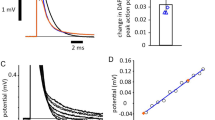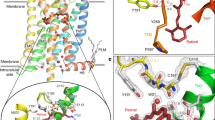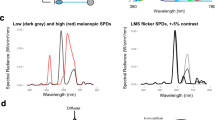Abstract
IRRADIATION of retinal tissue by brief intense flashes of light produces rapid changes in electrical potential. These changes, which occupy only 2–3 msec, are characterized by an initial cornea-positive wave followed by a negative one, and have been referred to collectively as the “early receptor potential” or e.r.p.1. Spectral sensitivity measurements clearly demonstrate that the e.r.p. results from the absorption of light by retinal rhodopsin2, but recent studies (in this and other laboratories) have revealed that an apparently similar potential can be obtained from flash irradiated tissues containing sufficiently high concentrations of melanin (for example, ocular pigment epithelium3,4, iris5 and frog skin5). This communication reports that yet another pigmented tissue, the green leaf, will also produce an “e.r.p. type” potential when irradiated under identical conditions. Important similarities, not only of waveform and time course but also in response to temperature change, suggest that there is a common fundamental mechanism.
This is a preview of subscription content, access via your institution
Access options
Subscribe to this journal
Receive 51 print issues and online access
$199.00 per year
only $3.90 per issue
Buy this article
- Purchase on Springer Link
- Instant access to full article PDF
Prices may be subject to local taxes which are calculated during checkout
Similar content being viewed by others
References
Brown, K. T., and Murakami, M., Nature, 201, 626 (1964).
Cone, R. A., Nature, 204, 736 (1964).
Brown, K. T., Nature, 207, 1249 (1965).
Brown, K. T., Watanabe, K., and Murakami, M., Cold Spr. Harb. Symp. Quant. Biol., 30, 457 (1965).
Arden, G. B., Ikeda, H., and Siegel, I. M., Vision Res., 6, 357 (1966).
Arden, G. B., and Ikeda, H., Vision Res., 6, 171 (1966).
Pak, W. L., and Cone, R. A., Nature, 204, 836 (1965).
Arden, G. B., Ikeda, H., and Siegel, I. M., Vision Res., 6, 373 (1966).
Brindley, G. S., and Gardener-Medwin, A. R., J. Physiol., 182, 185 (1966).
Pak, W. L., Cold Spr. Harb. Symp. Quant. Biol., 30, 493 (1965).
Cone, R. A., Cold Spr. Harb. Symb. Quant. Biol., 30 (1965).
Schmidt, W. J., Kolloid Z., 85, 137 (1938).
Denton, E. J., Proc. Roy. Soc., B, 150, 78 (1959).
General Discussion: Early Receptor Potential, Cold Spr. Harb. Symp. Quant. Biol., 30, 501 (1965).
Brown, K. T., and Gage, P. W., Nature, 211, 155 (1966).
Arden, G. B., Bridges, C. D. B., Ikeda, H., and Siegel, I. M., J. Physiol., 186, 123P (1966).
Brown, K. T., and Crawford, J. M., Physiologist, 9, No. 3 (1966).
Author information
Authors and Affiliations
Rights and permissions
About this article
Cite this article
ARDEN, G., BRIDGES, C., IKEDA, H. et al. Rapid Light-induced Potentials Common to Plant and Animal Tissues. Nature 212, 1235–1236 (1966). https://doi.org/10.1038/2121235a0
Published:
Issue Date:
DOI: https://doi.org/10.1038/2121235a0
This article is cited by
Comments
By submitting a comment you agree to abide by our Terms and Community Guidelines. If you find something abusive or that does not comply with our terms or guidelines please flag it as inappropriate.



